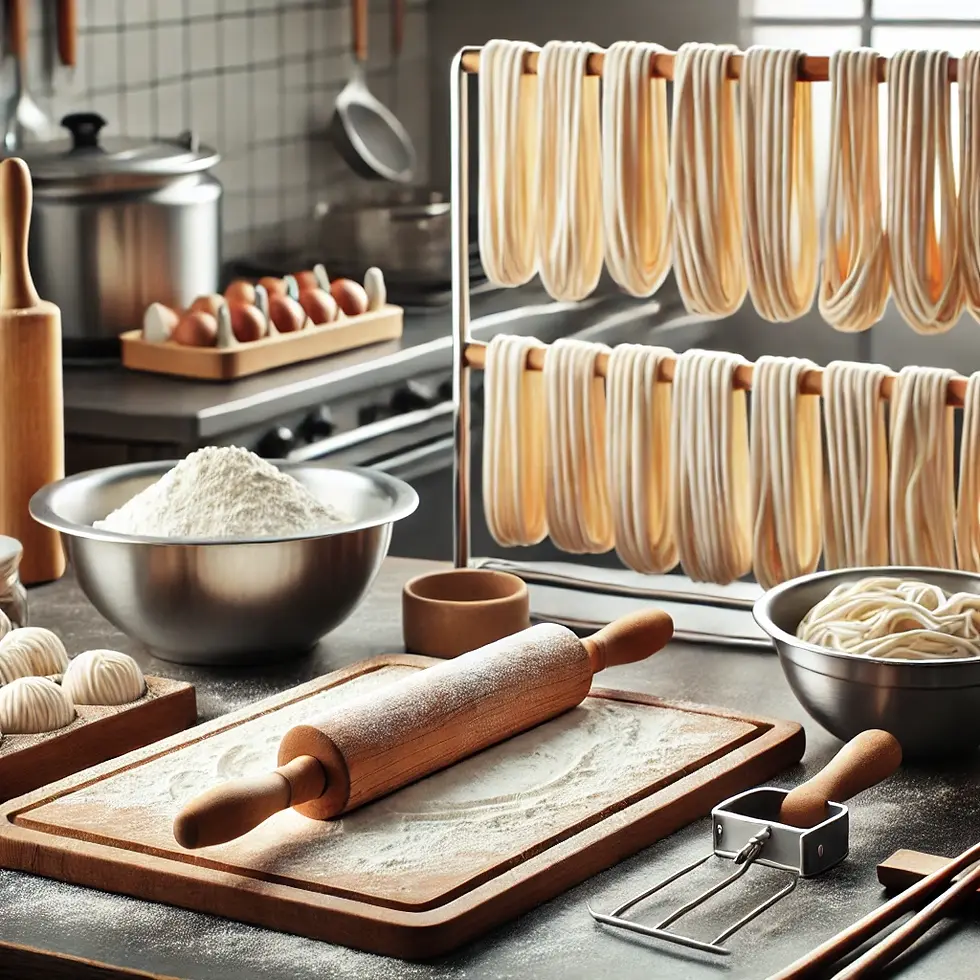The Art of Chinese Pulled Noodles: Mastering Tradition and Innovation: Chapter 1: Essential Tools and Ingredients
- Jaayson Neiuwkirk
- Feb 26
- 2 min read
The foundation of perfect Chinese pulled noodles begins with the right tools and ingredients. Whether you're making delicate hand-pulled lamian or thick, chewy Biang Biang noodles, having the proper equipment and understanding your ingredients can make or break your noodle-making experience. In this chapter, we'll explore the essential tools, ingredients, and techniques that set you up for success.

Part 1: Essential Tools
1. Mixing Bowls
Material: Stainless steel or glass is best.
Why: These materials maintain consistent temperature and are easy to clean.
Tip: Have multiple sizes on hand for scaling recipes.
2. Kneading Surface
Material: Wooden or silicone pastry boards.
Why: Provides a sturdy, non-slip surface for dough development.
Tip: Lightly flour the surface to prevent sticking.
3. Dough Cutters and Bench Scrapers
Material: Stainless steel.
Why: Helps divide dough evenly and clean work surfaces.
Tip: Use a bench scraper to handle sticky dough without adding excess flour.
4. Rolling Pins
Material: Wooden or silicone.
Why: Needed for shaping certain noodle types like Dao Xiao Mian.
Tip: Select a pin with adjustable thickness settings for consistency.
5. Noodle-Pulling Area
Setup: Clear a space at least 3 feet wide.
Why: Provides ample room to stretch and fold noodles.
Tip: Use a lightly oiled surface for smoother pulling.
6. Specialized Tools
Knife for Dao Xiao Mian: Sharp, thin blade for precision cuts.
Spatula: For scraping sticky dough remnants.
Part 2: Key Ingredients
1. Flour
Type: High-gluten or bread flour.
Why: Higher protein content strengthens gluten development.
Tip: Use unbleached flour for better elasticity.
2. Water
Type: Filtered water at room temperature.
Why: Minerals in tap water can affect gluten structure.
Tip: Adjust water content based on humidity.
3. Salt
Type: Non-iodized sea salt.
Why: Salt tightens gluten strands for better structure.
Tip: Dissolve salt in water before mixing with flour.
4. Optional Additives
Baking Soda: For extra chewiness in lamian.
Oil (e.g., sesame, vegetable): For smooth dough texture.
Part 3: Dough Preparation Basics
1. Measuring Ingredients
Use a digital scale for precision.
Flour-to-water ratio typically ranges from 2:1 to 3:1, depending on noodle type.
2. Mixing the Dough
Combine flour and salt, then gradually add water.
Mix until shaggy dough forms.
3. Kneading Techniques
Knead for 10–15 minutes until smooth and elastic.
Rest dough for at least 30 minutes to relax gluten.
4. Consistency Check
Press dough with a finger; it should bounce back slowly.
Pro Tips for Success
Temperature Control: Warm environments accelerate gluten development.
Hydration Adjustments: Adjust water content in dry or humid climates.
Practice Patience: Perfect dough texture comes with experience.
Mastering these fundamental tools and ingredients will prepare you for the exciting journey of crafting authentic Chinese pulled noodles. In the next chapter, we'll dive into the process of dough formation and pulling techniques.
Comments